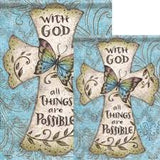Your Cart is Empty
Decorative Flags
Want to know everything about decorative flags? Well, as experts at Flagsrus we put this guide to put all the info together for you.
What's a Decorative Flag?
Decorative flags have a sleeve across the top. The standard size has tabs sewn in to attach to a pole. Decorative flags do not have grommets.
What are the Different Sizes Of Flags?
 The main sizes of flags are house, garden, estate or mini flags.
The main sizes of flags are house, garden, estate or mini flags.
-
Standard Flag or House Flag
Most house flags are about 28" x 40". House flags can be installed on a 60" pole. Bracket and pole are sold separately. Also referred to as "Decorative Banner”, "Banner Flag”, "House Flag”, and "Porch Flag”. -
Garden Flag
Most garden flags measure about 12.5" x 18". Garden flag can be hung from a small pole that pushes into the ground or can be attached to a mailbox post. Also called "Mini Flag”, "Yard Flag” or "Mailbox Flag”. -
Estate Flag
Estate Flags are larger flags measuring about 36" x 54" that hang from the same standard flagpole -
Mini Flag
Mini Flags are very small flags that are 6" x 13" in size, to decorate window boxes, plant pots or even cakes
What are the Different Types Of Flags?
There are two basic types of decorative flags:
-
Printed
Printed flags are made of fade-resistant polyester with artwork transferred to fabric through heat sublimation technique. -
Appliqued
All Appliqued flags have bright colors on fade-resistant fabrics. These are not heat sublimated. They look stitched like a quilt. They have different sizes within a given vendor. You should not put them in a dryer. Single Applique flags are good value, quality applique flags. The flag looks great on both sides because of tight embroidery. Double Applique flag is actually two flags sewn together with batting between them, this makes any message on the flag readable on both sides and gives a 3D effect.
What are the Different Kinds Of Flag Fabric?
Most manufacturers use a variation of polyester, but call it by a different name. Sublimated Flags are available in 2 types. Other choices in fabric are burlap, linen or metal.
-
Standard Polyester
Standard Polyester is weather-resistant, fade-resistant and durable, yet has a softness that allows for excellent drape and movement in the breeze. This fabric isn't as prone to fuzzing as the thick polyester. Permanently dyed, vivid, machine washable. Leave to drip dry, can put in a dryer at your own risk. -
Soft & Thicker Polyester
These are made of soft & thicker polyester to allow printing on both sides. They are velvety soft and smooth. If flags are hung where they are likely to be rubbing or bumping against shrubs or a building, these flags are not the best option because it will 'fuzz'. Machine washable but leave to drip dry. -
Burlap
Burlap flags are elegant decorative flags for your yard. Evergreen and Custom Decor Burlap flags are made of durable burlap and feature an elegant look. Toland Burlap Flags have the rustic look and feel of burlap, but are made of polyester. -
Linen
Linen flags are made of high quality, polyester based linen like fabric, specially treated to withstand changing outdoor weather conditions. Available currently from Evergreen. -
Metal
Metal Flags are made with light weight, powder coated metal that is designed to withstand changing outdoor weather conditions. Available from Carson.
Are Flags One Sided or Two Sided?
Most flags are single sided with design printed on one side and shows through in the back side as a reverse image.
 |
Some flags have design printed on both sides but text can be read correctly only from one side. |
 |
Some flags have design printed on both sides but text can be read correctly only from one side. |
 |
Then there are those double sided flags where two different designs are sewn together back to back so you essentially have a two in one flag. |
How Should I Take Care Of My Flag?
Taking down your flag daily after daylight is gone and during inclement weather, can significantly increase its life!
-
Cleaning Your Flag: Regular cleaning of outdoor flags to remove dirt, dust etc will prevent such contaminants from getting set into the fabric. Proper cleaning will help retain fresh, bright colors and increase life of your flags.
DO NOT MACHINE WASH, as machine washing can cause wearing of fabric and fading of colors. Gently hand wash with a mild detergent and cold water. Do not let the flag sit on detergent water for a prolonged period of time, as it can cause bleeding or running of colors.
After washing, rinse out all the detergent in cold water and spread out completely to air dry. DO NOT PUT YOUR FLAGS IN THE DRYER.
Do not bleach or dry clean your flags as they can cause permanent damaging of fibers or colors.
Flags in general do not require ironing. If you wish to iron, do not use hot iron directly on your flag. Use a warm iron at a very low heat setting on the back of the flag. -
Storage: DO NOT FOLD, ROLL UP OR STORE FLAGS WHEN WET. Dampness can lead to mildew, mold or fungus, discoloration and associated damaging of your flag. Always completely dry your flag before folding or storing.
Store the flag (in fully dry state) in a cool, dry and dark place. Use a flag storage organizer for safe storage of your decorative flags. -
Harsh Weather Tip: We strongly suggest that you take down your outdoor flags during abnormally harsh weather conditions like high winds, storms, heavy rains, snowfall and hailstorms as they can damage or accelerate the wearing of flags. Flags tend to get heavier as they get wet, and strong wind on heavy flags will strain the fabric and stitches, there by accelerating damages to them.
We highly recommend taking down your flags at night during inclement weather seasons as such conditions can be left unnoticed otherwise. -
Maintenance & Repair Tips: Stitch in time saves nine! Minor damages or tears to ends, left unattended can lead to irreparable damages of your flag. Periodically watch the "fly" end of your flag (the farthest end from the pole) for signs of wear or tear. Small rips or thread breaks in the ends can be easily fixed by trimming off and re-hemming. Small tears can be hand-stitched or machine sewn.
-
Have a minimum of 2 or 3 Flags:Above easy steps can help you with dramatic increase in the life of your flags! However, for ardent flag lovers, we recommend having more than one flag (two or three!), so that you can always have a fresh flag flying in your yard, while you have another in washing & drying or repair and another fresh flag in storage ready for use.

